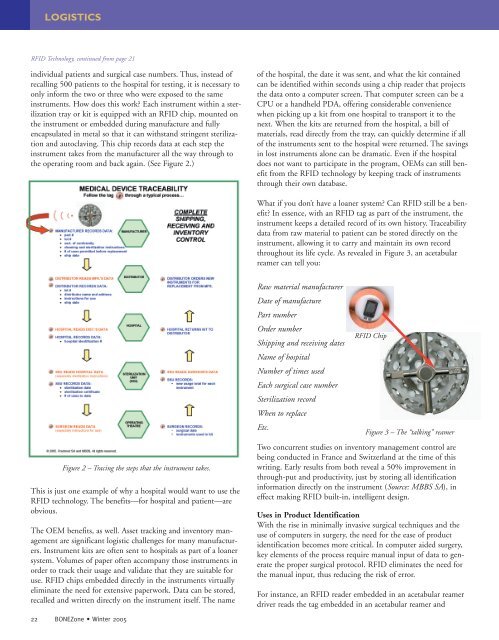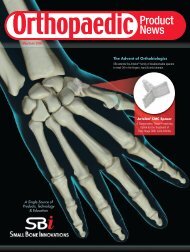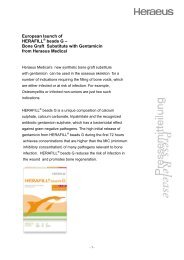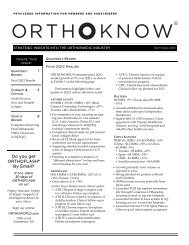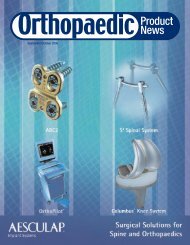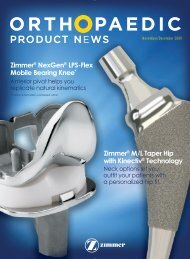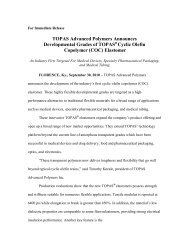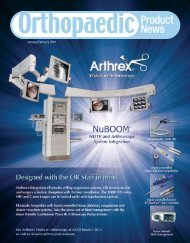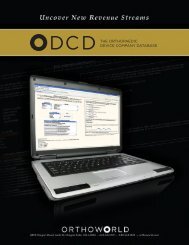The 2006 Supplier Directory - Orthoworld
The 2006 Supplier Directory - Orthoworld
The 2006 Supplier Directory - Orthoworld
Create successful ePaper yourself
Turn your PDF publications into a flip-book with our unique Google optimized e-Paper software.
LOGISTICS<br />
RFID Technology, continued from page 21<br />
individual patients and surgical case numbers. Thus, instead of<br />
recalling 500 patients to the hospital for testing, it is necessary to<br />
only inform the two or three who were exposed to the same<br />
instruments. How does this work? Each instrument within a sterilization<br />
tray or kit is equipped with an RFID chip, mounted on<br />
the instrument or embedded during manufacture and fully<br />
encapsulated in metal so that it can withstand stringent sterilization<br />
and autoclaving. This chip records data at each step the<br />
instrument takes from the manufacturer all the way through to<br />
the operating room and back again. (See Figure 2.)<br />
Figure 2 – Tracing the steps that the instrument takes.<br />
This is just one example of why a hospital would want to use the<br />
RFID technology. <strong>The</strong> benefits—for hospital and patient—are<br />
obvious.<br />
<strong>The</strong> OEM benefits, as well. Asset tracking and inventory management<br />
are significant logistic challenges for many manufacturers.<br />
Instrument kits are often sent to hospitals as part of a loaner<br />
system. Volumes of paper often accompany those instruments in<br />
order to track their usage and validate that they are suitable for<br />
use. RFID chips embedded directly in the instruments virtually<br />
eliminate the need for extensive paperwork. Data can be stored,<br />
recalled and written directly on the instrument itself. <strong>The</strong> name<br />
22 BONEZone • Winter 2005<br />
of the hospital, the date it was sent, and what the kit contained<br />
can be identified within seconds using a chip reader that projects<br />
the data onto a computer screen. That computer screen can be a<br />
CPU or a handheld PDA, offering considerable convenience<br />
when picking up a kit from one hospital to transport it to the<br />
next. When the kits are returned from the hospital, a bill of<br />
materials, read directly from the tray, can quickly determine if all<br />
of the instruments sent to the hospital were returned. <strong>The</strong> savings<br />
in lost instruments alone can be dramatic. Even if the hospital<br />
does not want to participate in the program, OEMs can still benefit<br />
from the RFID technology by keeping track of instruments<br />
through their own database.<br />
What if you don’t have a loaner system? Can RFID still be a benefit?<br />
In essence, with an RFID tag as part of the instrument, the<br />
instrument keeps a detailed record of its own history. Traceability<br />
data from raw material to patient can be stored directly on the<br />
instrument, allowing it to carry and maintain its own record<br />
throughout its life cycle. As revealed in Figure 3, an acetabular<br />
reamer can tell you:<br />
Raw material manufacturer<br />
Date of manufacture<br />
Part number<br />
Order number<br />
Shipping and receiving dates<br />
Name of hospital<br />
Number of times used<br />
Each surgical case number<br />
Sterilization record<br />
When to replace<br />
Etc.<br />
RFID Chip<br />
Figure 3 – <strong>The</strong> “talking” reamer<br />
Two concurrent studies on inventory management control are<br />
being conducted in France and Switzerland at the time of this<br />
writing. Early results from both reveal a 50% improvement in<br />
through-put and productivity, just by storing all identification<br />
information directly on the instrument (Source: MBBS SA), in<br />
effect making RFID built-in, intelligent design.<br />
Uses in Product Identification<br />
With the rise in minimally invasive surgical techniques and the<br />
use of computers in surgery, the need for the ease of product<br />
identification becomes more critical. In computer aided surgery,<br />
key elements of the process require manual input of data to generate<br />
the proper surgical protocol. RFID eliminates the need for<br />
the manual input, thus reducing the risk of error.<br />
For instance, an RFID reader embedded in an acetabular reamer<br />
driver reads the tag embedded in an acetabular reamer and


